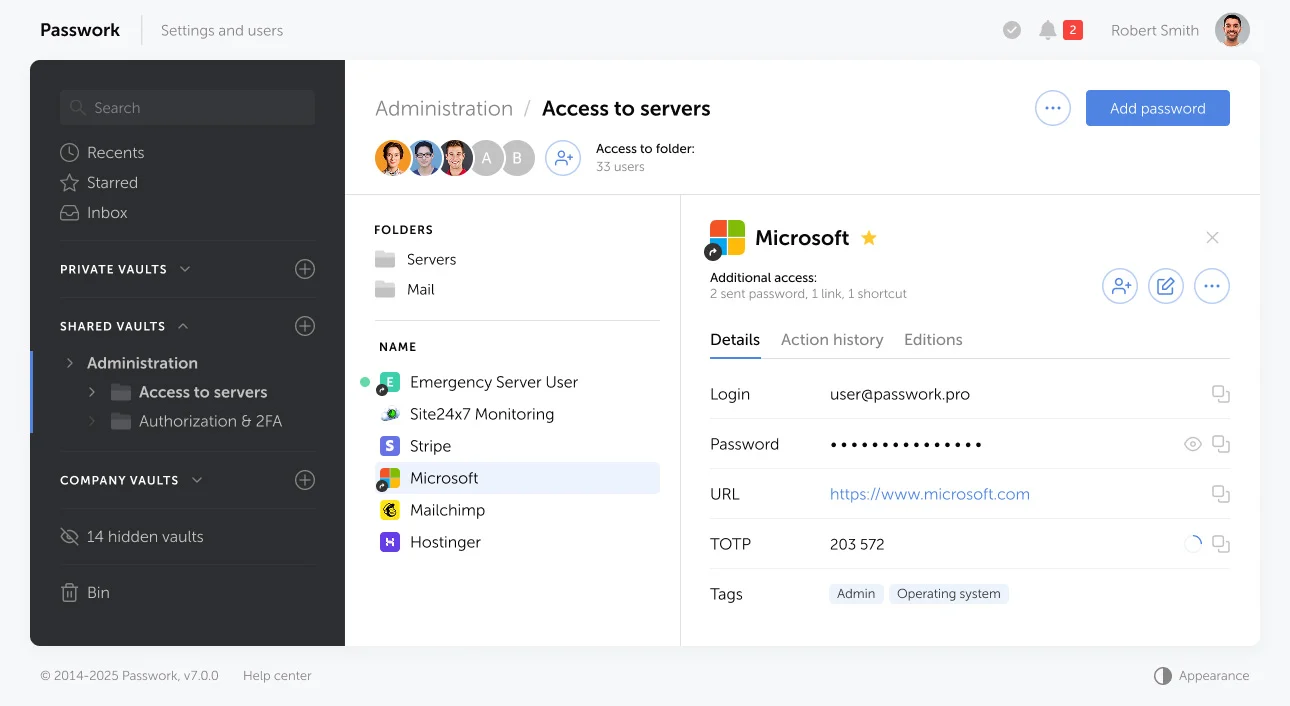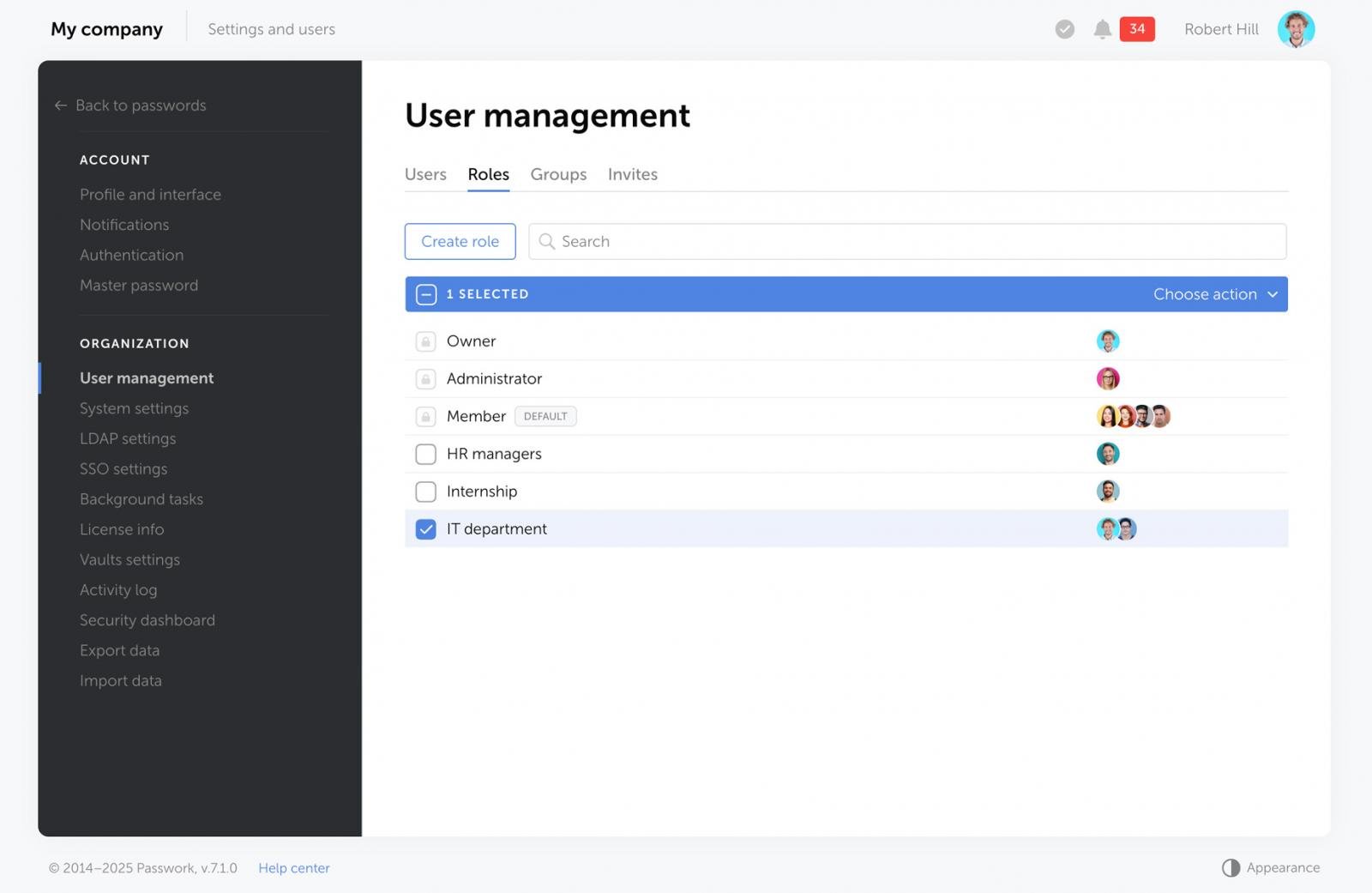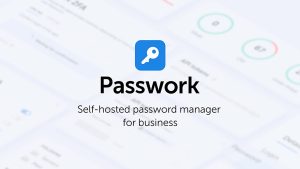Author: Eirik Salmi, System Analyst at Passwork
Organizations manage credentials across distributed teams, applications, and infrastructure — passwords, API keys, certificates, and tokens that require different access patterns and security controls. Traditional password managers address individual user needs but weren’t designed for operational complexity at scale.
Different roles have different requirements: DevOps teams need programmatic access, security teams demand audit trails, IT admins require granular control. This creates demand for platforms that handle both human and machine credential management within a unified framework.
In its new release, Passwork introduces changes to credential organization, access control, and administrative functionality based on feedback from production environments. The update focuses on usability improvements and security refinements, with attention to workflow efficiency and feature accessibility.
Passwork 7 addresses a concrete operational need: maintaining credential security, enforcing access policies, and enabling team collaboration without disrupting existing workflows. This review examines version 7’s practical capabilities and integration characteristics.
What is enterprise password management
Enterprise password management goes beyond storing login credentials. It encompasses the complete lifecycle of sensitive authentication data across an organization: secure generation, encrypted storage, controlled access, automated rotation, and comprehensive auditing.
Unlike consumer password managers, enterprise solutions must support complex organizational structures, integrate with existing infrastructure (LDAP, SSO), provide role-based access control (RBAC), and maintain detailed compliance logs. For organizations managing hundreds of employees and thousands of credentials, these capabilities are essential.
The secrets management challenge
While passwords serve as authentication mechanisms for human users, secrets function as authentication credentials for machine-to-machine communication. API keys, database connection strings, SSH keys, access tokens, and digital certificates enable applications, services, and automated processes to establish secure connections across distributed systems.
The challenge lies in scale and distribution. Modern infrastructure generates secrets at an accelerating rate — embedded in configuration files, injected as environment variables, referenced in deployment manifests, and occasionally exposed in version control systems. Without centralized governance, organizations encounter systemic risks:
-
Security exposure: Hardcoded credentials in application code create persistent attack surfaces and expand the blast radius of potential breaches.
-
Operational chaos: Scattered secrets across systems make rotation nearly impossible
-
Compliance gaps: Absence of centralized audit mechanisms eliminates visibility into access patterns, credential usage, and policy enforcement.
-
DevOps bottlenecks: Manual credential distribution slows deployment pipelines.
Effective secrets management addresses these challenges through centralized storage, automated rotation, programmatic access, and complete operational transparency.
A full-featured trial is available with no feature limitations. A Black Friday promotion runs from November 26 through December 3, 2025, with discounts reaching 50%.
Organizations already planning credential management implementations may find value in testing now and purchasing during this period.
Passwork 7: Two products in one unified platform
The platform evolved beyond traditional password storage into a comprehensive secrets management platform. The system now combines two full-fledged products in one unified interface:
-
Password manager: An intuitive interface where employees securely store and share credentials for daily work. The streamlined design reduces onboarding time, making it practical for organizations where staff have varying technical expertise.
-
Secrets management system: Programmatic access through REST API, Python connector, CLI, and Docker containers enables DevOps teams to automate credential workflows without compromising security.

This dual functionality eliminates the need for separate tools, reducing complexity and licensing costs while improving security posture.
Key features of Passwork for enterprise security
Passwork’s feature set solves the practical challenges of enterprise credential security: structuring access across departments, maintaining audit trails for compliance, and automating credential management without rebuilding workflows.
Flexible vault architecture
Like most enterprise password management platforms, Passwork organizes data hierarchically: passwords nested in folders, folders contained within vaults. The structure is familiar, but Passwork’s vault layer offers more granular control and flexibility in how access is defined and distributed.

Version 7 introduced a vault types architecture that transforms how organizations structure credential access. The system provides three approaches:
-
Company vaults automatically include corporate administrators alongside the vault creator. This ensures continuous oversight — administrators cannot be removed or demoted, guaranteeing that leadership maintains visibility into critical credentials.
-
Custom vault types represent the most powerful option. Administrators can create unlimited vault types tailored to specific departments, projects, or security requirements. For each custom type, you define designated administrators, configure creator permissions, and establish rules about who can create new vaults.

This flexibility allows organizations to mirror their internal structure within Passwork. An IT director manages IT vaults, the finance director oversees financial credentials, and HR maintains employee access information — all within a single platform with appropriate isolation and oversight.
Meanwhile, a security administrator can be granted access across all vaults for audit and compliance purposes without disrupting departmental autonomy.
Organizations with strict security policies can disable user vault creation entirely, enforcing a model where all credentials reside exclusively in company-controlled or custom vault types.
Granular access control with RBAC and user groups
Access control in Passwork operates through a role-based system that scales from small teams to enterprise deployments. Administrators create roles that define specific permissions — what actions users can perform within the system.
The system imposes no artificial limits on role creation, enabling organizations to implement precisely tailored permission structures.
You might grant certain users rights to manage specific roles and groups while restricting access to system configurations. Department heads receive control over their team’s credentials without accessing other departments’ data.

User groups further streamline permission management. By adding users to a group, they automatically inherit the group’s permissions across relevant vaults and folders.
This approach reduces administrative overhead when onboarding new team members or restructuring departments.
Secure credential sharing for internal and external users
Passwork offers multiple methods for credential sharing, each designed for specific use cases:
-
Internal sharing enables credential distribution to individuals or groups within your company. Permissions cascade through the vault and folder hierarchy, ensuring users access exactly what they need without exposing unrelated credentials.
-
External sharing addresses the common challenge of securely providing credentials to contractors, vendors, or temporary partners. Passwork generates secure, time-limited links that grant access without requiring external users to create accounts or install software.

The platform also offers granular password sharing through its internal password sending system and shortcuts. Access can be revoked at any time, and the system automatically reminds administrators through the security dashboard which users previously had access to each credential.
Every sharing action generates audit logs, providing complete visibility into credential access patterns and supporting compliance requirements.
Complete audit trails and compliance
Every action in Passwork generates activity log entries. Track who accessed which credentials, when, and what actions they performed. Export logs for analysis or integration with SIEM systems.

This operational transparency facilitates regulatory compliance (SOC 2, ISO 27001, GDPR) and enables rapid incident response.
When suspicious activity occurs, administrators can quickly identify affected credentials and revoke access.
Enhanced notification system
In addition to audit logs Passwork 7 introduced customizable notifications with flexible delivery options. Users choose notification types and delivery methods — in-app or email — for authentication events and activity log entries.

Each event type can be configured independently. Receive critical security alerts via email immediately. View routine activity updates in-app when convenient. Disable notifications entirely for specific event types.
Integration with corporate identity infrastructure
Enterprise deployments require native integration with existing authentication systems.
Passwork delivers this through comprehensive SSO and LDAP support. Disable an account in Active Directory, and Passwork access revokes immediately.
Automation tools: Python connector, CLI, and Docker
Solution is built on API-first principles, meaning every function available in the user interface is accessible through REST API. This architecture enables complete programmatic control over the platform.
The API provides access to all system functions: password management, vault operations, folder structures, user administration, role assignments, tags, file attachments, and comprehensive event logs.
This allows DevOps teams to automate access provisioning, update credentials programmatically, integrate Passwork into deployment pipelines, and export logs for security analysis.
Passwork provides multiple automation tools designed for different workflows:
-
Python connector — The official Python library eliminates complexity by abstracting low-level API calls and cryptographic operations.
-
Command-line interface — The CLI enables shell script integration and manual credential management from the terminal. DevOps engineers can incorporate Passwork operations into deployment scripts, automation workflows, and system administration tasks.
-
Docker container — Official Docker image simplifies deployment in containerized environments. This approach integrates naturally with Kubernetes, container orchestration platforms, and microservices architectures.
Zero-knowledge architecture
Passwork’s Zero knowledge mode encrypts all data client-side before transmission. Even if attackers compromise the server, they cannot decrypt stored credentials.
Each user maintains their own master password, never transmitted to the server. Only the user can decrypt their accessible credentials.
This architecture provides maximum security for organizations handling highly sensitive data.
Self-hosted deployment
Passwork operates as a self-hosted password manager, meaning the entire platform runs on your infrastructure — whether on-premises servers or private cloud environments. No credentials ever touch third-party servers.
This deployment model addresses critical requirements that cloud-based solutions cannot satisfy:
-
Data sovereignty and compliance: Organizations subject to GDPR, HIPAA, or sector-specific regulations maintain complete control over credential data location and residency policies.
-
Network isolation: Deploy within air-gapped networks or segmented security zones. Critical credentials never traverse public internet connections.
-
Custom security policies: Implement your own backup strategies, encryption standards, access controls, and monitoring systems. Define precisely how Passwork integrates with existing security infrastructure.
-
Zero vendor dependency: Cloud password managers introduce risks — service outages, policy changes, acquisitions. Self-hosting eliminates this variable entirely.
For enterprises where credential security cannot depend on external providers, self-hosted architecture is foundational.
Why choose Passwork for enterprise environments
Passwork 7 addresses the fundamental challenge facing modern IT organizations: managing both human and machine credentials within a single, secure platform.
-
Self-hosted deployment keeps sensitive data within your infrastructure, satisfying data residency requirements and regulatory constraints.
-
Unified platform eliminates the need for separate password and secrets management tools, reducing costs and complexity.
-
API-first architecture enables comprehensive automation without sacrificing usability for non-technical staff.
-
Flexible access control supports complex organizational structures through unlimited custom roles and vault types.
-
Zero-knowledge encryption protects against server compromise, providing maximum security for sensitive credentials.
-
Complete automation through Python connector, CLI, and Docker integration streamlines DevOps workflows.
For organizations seeking enterprise password management and secrets management within a single solution, Passwork delivers security, flexibility, and automation.
Migrating from other password managers
Passwork supports migration from existing password management solutions, enabling organizations to transition without losing data. The platform provides import tools and documentation for common formats, streamlining the migration process.
Planning your vault structure before migration ensures optimal organization from day one. Consider how your departments, projects, and teams should map to vault types, and establish permission structures that reflect your security policies.
The company provides a 10% discount for organizations migrating from other password managers, making the transition both technically seamless and financially advantageous.
Conclusion
Passwork delivers a unified approach to password and secrets management that prioritizes practical deployment over theoretical features. The vault architecture, access control model, and interface design accommodate organizations across different scales and operational contexts.
Centralized credential management reduces the need for multiple specialized tools, integrates with existing infrastructure through SSO and LDAP, and supports collaboration workflows without requiring significant process changes.
The platform holds ISO 27001 certification, demonstrating compliance with internationally recognized information security management standards — essential for organizations in regulated sectors or those handling sensitive data under strict governance requirements.
Free trial options and Black Friday offers
A full-featured trial available with no feature limitations. This provides an opportunity to evaluate the platform against your actual infrastructure, security policies, and team workflows before committing.
If the trial meets your requirements, A Black Friday promotion runs from November 26 through December 3, 2025, with discounts reaching 50%. Organizations already planning credential management implementations may find value in testing now and purchasing during this period.
For businesses seeking to consolidate credential management, strengthen security posture, and establish audit-ready access governance, Passwork 7 provides a comprehensive solution designed for rapid deployment with minimal operational disruption.
Sponsored and written by Passwork.
VIA: bleepingcomputer.com










